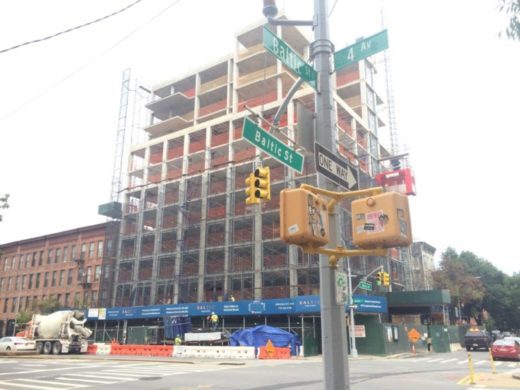
Next year, Margarita Lopez will have new neighbors… again. Park Slope is on the rise. But for Lopez, it’s a difficult time to be in the Brooklyn neighborhood. Like many other Park Slope residents, she has noticed the influx of tall, glamorous buildings, but she feels boxed in by all the construction along Fourth Ave.
Lopez, 60, is a neighborhood native, but at first glance she looks out of place. She spends a lot of time on Fourth Ave., once a hub for industrial businesses and small-family homes, parked outside on a chair behind a 4-foot gate, right next to her mother. They huddle in a mini-courtyard outside of the house, which her mother bought in 1964. It is an odd sight, considering that several buildings on the block are not marked by porches or fences. Instead, doormen wait inside the revolving glass doors, welcoming the bustling residents home.
Most afternoons, construction workers are hanging out across the street, underneath the scaffolding of the Baltic: an 11-story, luxury condo building that gets its name from its location at the intersection of Baltic St. and Fourth Ave. The Baltic will feature a rooftop terrace and an outdoor cinema. It’s a big change from the laundromat that once stood in its place.
On the other side of Lopez, a dozen men in hard hats are putting finishing touches on the framework of another luxury rental by a different developer, 595 Baltic St., which will open later this year.

It’s no coincidence that within a two-block stretch, four other high-rises have sprouted up along the avenue in the last few years. Carlos Scissura, president of the Brooklyn Chamber of Commerce, told the New York Times in February that the block “could be the next Park Ave.”
It might be well on its way. Available apartments in the Baltic range from $1.4 million to more than $2 million, according to StreetEasy, a real estate listing site.
Lopez sees this as a classic example of gentrification. “People with money move in,” she said. “The average person can’t afford that.”
Since 2005, the median cost of rent has risen 14 percent in Park Slope, according to the most recent data from the Furman Center for Real Estate and Urban Policy. In 2015, the median sales price for a home in a building with five families or more nearly doubled from the previous year to $410,000.
The new inhabitants of the up-and-coming luxury buildings might mean a boost for small businesses along Fourth Ave, according to Marcel Torchio, owner of Il Vino Torchio, a wine shop in the neighborhood. But with new customers also comes a threat to his business: As high-rises make their way to the block, rent for storefronts soars.
That’s a narrative far too familiar to local shops in Park Slope. Last year, Eagle Provisions, a Polish beer and food shop, shut its doors after more than 70 years in business. The owners sold the property for $7.5 million, according to the Commercial Observer. Luxury apartments, complete with a 14-car garage and a roof deck, will soon stand in its place.
Torchio does not deny the swift changes in the neighborhood. “At some point it will happen to me,” he said. “Probably one day” a luxury building will replace the shelves of wine.
Shifts in zoning regulations have made it easier for developers to build taller apartment buildings along Fourth Ave., which stretches for nearly six miles.
Felipe Pedraza, an independent real estate broker based in Park Slope, attributes the surge of new construction to the Barclays Center, which opened in 2012.
“There has been an aggressive plan to make the area less industrial,” Pedraza, who lived in Park Slope in the late 1960s, said. “In five years, you’ll see even more glass buildings.”
If construction goes as scheduled for recently filed plans, more than a dozen other luxury high-rises will be coming to Fourth Ave.
This might mean a change in Lopez’s routine—less time spent sitting outside—but she is determined to avoid the traditional fate of gentrification.
“My mom will never sell the house,” Lopez said, “because where would she go?”


Leave a Reply